I have a sweet potato vine growing in a container in my kitchen window, and I keep wondering if it would actually grown a sweet potato underneath the soil. Perhaps so. From a poster at one of the listservs I am subscribed to, she cites her experience with sweet potatoe vines...and it sounds like it was an unexpected surprise to her to find actual sweet potatoes growing.
I am put off a bit by learning the sweet potato is a cousin to the morning glory vines, and yes, the leaves of the vine do look much like the morning glory vines in my yard. Since I already 'fight' with the spreading morning glory vines that never really are eradicated, but I try to keep them from overtaking our intentional plantings, I'm not sure I would want to generate another aggressive vine spreader with sweet potatoes. So, I will think some about this, how I can grow and keep contained, because I do want sweet potatoes - Yes!
A shout out of thanks to Brenda for sharing her experience (below):
I just took pieces that were sprouting & put them against a chain link fence. The vines grew all over the fencing. Then they branched out all over my garden.. like weeds. When the leaves started to die a little, you could see the potatoes peeking up from the mound at the base of the plant. As I started pulling up the runners, I kept finding more.
They are a member of the morning glory family & the vines act like it... I had one potato that was the size of a coconut!! No special care. Didn't water them any more than the normal grey water from the laundry & whatever water God gave me. No pesticides. A little mulch from the horse stable but nothing special. I harvested more today. Very hardy. Willing to take over the world if you let it.
Read more
I am put off a bit by learning the sweet potato is a cousin to the morning glory vines, and yes, the leaves of the vine do look much like the morning glory vines in my yard. Since I already 'fight' with the spreading morning glory vines that never really are eradicated, but I try to keep them from overtaking our intentional plantings, I'm not sure I would want to generate another aggressive vine spreader with sweet potatoes. So, I will think some about this, how I can grow and keep contained, because I do want sweet potatoes - Yes!
A shout out of thanks to Brenda for sharing her experience (below):
I just took pieces that were sprouting & put them against a chain link fence. The vines grew all over the fencing. Then they branched out all over my garden.. like weeds. When the leaves started to die a little, you could see the potatoes peeking up from the mound at the base of the plant. As I started pulling up the runners, I kept finding more.
They are a member of the morning glory family & the vines act like it... I had one potato that was the size of a coconut!! No special care. Didn't water them any more than the normal grey water from the laundry & whatever water God gave me. No pesticides. A little mulch from the horse stable but nothing special. I harvested more today. Very hardy. Willing to take over the world if you let it.




